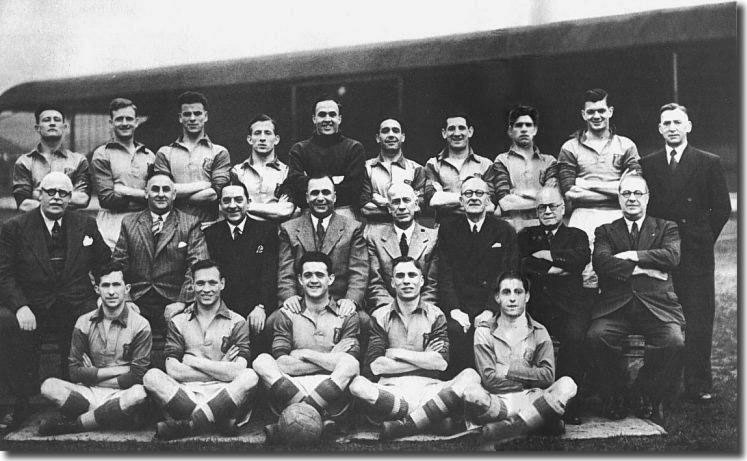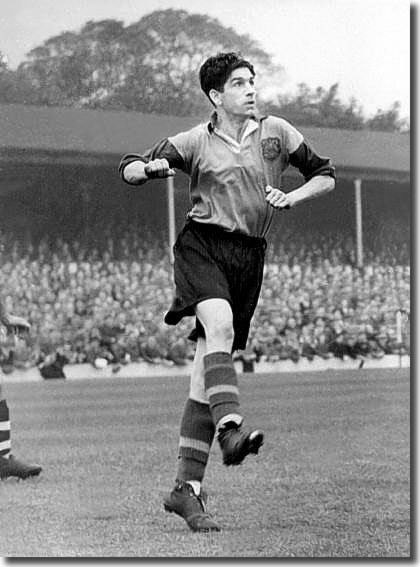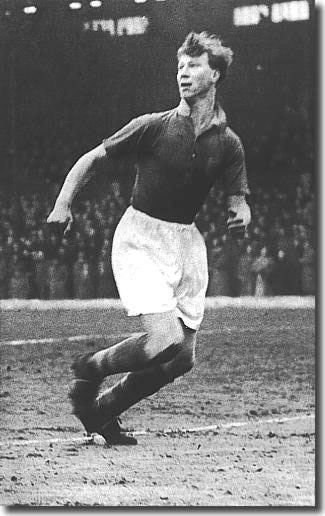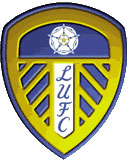 Major
Frank Buckley had started making changes to the Leeds United set up
in 1948/49, but they made little difference to
fortunes on the field. The club finished just a couple of points off relegation,
but Buckley had greater success in his next 12 months in charge. He had
had the chance to take a critical look at the players he had at his disposal
and had decided that many were simply not up to the mark - there was just
too much dead wood.
Major
Frank Buckley had started making changes to the Leeds United set up
in 1948/49, but they made little difference to
fortunes on the field. The club finished just a couple of points off relegation,
but Buckley had greater success in his next 12 months in charge. He had
had the chance to take a critical look at the players he had at his disposal
and had decided that many were simply not up to the mark - there was just
too much dead wood.
There were many comings and goings in the summer of 1949 as Buckley commenced
some fairly radical surgery. In some cases, that meant players who had
only recently been brought in were disposed of. Cliff Marsh, Roly Depear,
Albert Lomas and Walter Edwards were all Buckley signings who, for one
reason or another, had left Elland Road by August 1949, and another two,
Jimmy Rudd and David McAdam, followed by the end of the season. 35-year-old
keeper Jim Twomey was on his way to Halifax in August and another 35-year-old,
centre-half Tom Holley, retired after 164 league games for the club, replaced
by the teenage sensation John Charles.
Centre-forward Albert Wakefield, who had been top scorer in 1947/48,
left in a player-exchange deal for Southend's 24 year old forward Frank
Dudley. The big signing of the summer, though, was winger Harold Williams
who cost £12,000 from Newport County. Williams, with his tiny feet and
wonderful balance, had caught Buckley's eye the previous season when he
had given the Leeds defenders a hard time in the Cup upset against the
Welsh club. He already had two Welsh caps to his credit and could play
on either wing, pleasing Buckley, who loved two footed players.
The Leeds side that year had an unmistakable Buckley-esque feel to it
and gave him great hope for the future. Goalkeeper Harry Searson was a
Buckley signing from Mansfield for £2,000 in January and was an ever present.
Full-backs Jimmy Dunn and Jim Milburn had been at Elland Road when Buckley
arrived but were his sort of players. John Charles had been blooded at
the end of the previous season and was now a fixture at centre-half, playing
alongside Jim McCabe, a big money buy from Middlesbrough at the end of
Willis Edwards' reign, and skipper
Tommy Burden, who had been a teenage prodigy at Buckley's Wolves. Both
Charles and Burden played in every match that year. The defence finally
started to provide the cohesion that had been lacking for years.
Williams and Irishman David Cochrane were wide providers up front, where
Len Browning and Dudley were the main threat. But the attack did not always
click. At 6ft 2in, Browning had an imposing physical presence and Dudley,
who packed a fierce shot, could unsettle defences, with surging runs on
goal; but neither quite had the craft or consistency to be persistently
threatening in front of goal.
Those players who weren't Buckley signings were certainly being moulded
to his grand design. By 1949/50 the Leeds United team was more settled
and assured.
The side didn't start off very impressively, however, winning just one
of their first 11 matches, and were struggling in the relegation zone
early on, but gradually the Buckley influence was felt and the players
got their act together. Charles was a surprisingly mature teenager at
the heart of a defence which was now a tough nut to crack. They kept thirteen clean sheets and conceded more than two goals on just four
occasions in 47 matches. This was something that had been unheard of in
recent seasons. Three of the clean sheets came in consecutive wins in
October as Leeds got their season rolling, with Dudley scoring in each
game. Hull City turned Leeds over 1-0 on October 29, but that was the
only reverse in a run of 9 games that saw Leeds pull away from the bottom
of the table.
kept thirteen clean sheets and conceded more than two goals on just four
occasions in 47 matches. This was something that had been unheard of in
recent seasons. Three of the clean sheets came in consecutive wins in
October as Leeds got their season rolling, with Dudley scoring in each
game. Hull City turned Leeds over 1-0 on October 29, but that was the
only reverse in a run of 9 games that saw Leeds pull away from the bottom
of the table.
It was around this time that Buckley signed Stalybridge Celtic's Eric
Kerfoot, who went on to make more than 300 appearances for the club. He
was an outstanding non-League half back and made his debut for Leeds after
a single reserve game. He only played a few games that season, as cover
for Jim McCabe, but made a more telling impact in later years.
Leeds lost 2-0 at Bury on 10 December but had taken on the proportions
of a rolling juggernaut. As Leeds pushed up the table in mid-season, Buckley's
team played before an increasing number of huge crowds at Elland Road:
41,303 saw a 3-1 win against Preston on Christmas Eve; 47,817 a victory
over Barnsley on 27 December; and 50,476 a 3-0 win against leaders Tottenham
on 14 January, during which David Cochrane, in irrepressible form on the
right wing, tore Spurs' defence to pieces.
They had another unbeaten run, this time of 13 matches, which encompassed
impressive progress in the FA Cup. United had probably the poorest Cup
record of any side in the top two divisions. They had only ever made it
to the fifth round twice in their history, in 1933 and 1936, and had progressed
beyond the third round on just two occasions since 1936. However, 1950
saw a dramatic improvement in their fortunes.
Leeds easily disposed of Third Division side Carlisle in the third round,
by 5-2 on their own pitch. That secured a difficult fourth round tie against
First Division Bolton, whose centre-forward Nat Lofthouse was to be such
a force in the 1950's. Leeds only managed to draw 1-1 at Elland Road,
and were odds-on to go out in the replay at Burnden Park. However, the
players showed real mettle, digging into their mental and physical reserves
on a quagmire of a pitch at Burnden Park to win 3-2 in extra-time, a victory
which amazed even their most loyal supporters. 51,488 fans had witnessed
the first game against Bolton and more than 53,000 attended the fifth
round match against Second Division rivals Cardiff on 11 February. Leeds
had already beaten the Welshmen 2-0 in the league at Elland Road and gave
them similar treatment in the Cup, winning 3-1. Ray Iggleden got the vital
third goal, having fought his way back into the side at the beginning
of January.
A fortnight later, Leeds visited Cardiff in a Second Division game and
saw their long unbeaten run ended, as City got their revenge, winning
by the only goal.
The sixth round was new territory for Leeds and they faced a massive
battle on 4 March, away to mighty Arsenal, a club with a wonderful history,
having been reshaped by former Leeds City manager Herbert
Chapman to be the dominant club side of the Thirties. The Gunners
had recaptured the league title in 1948 and were still a power in the
land. Thousands of West Yorkshire fans made the trip to London for the
game and made their presence felt as a new and vibrant Leeds outfit set
about their illustrious opponents. Buckley's men, by no means overawed
by the occasion or by the 62,973 crowd, played superbly, defending in
depth and counter attacking effectively. But they were beaten by the only
goal of the game, prodded in by Reg Lewis after 52 minutes and despite
a desperate late onslaught, could not fashion an equaliser. The Gunners
went on to win the trophy, beating Liverpool in the final, but Leeds had
run them very close and proved that they were, indeed, a force to be reckoned
with.
back to top
The team's form petered out thereafter and the efforts had obviously
taken their toll. They crashed 5-2 at Sheffield Wednesday on 25 March
in their worst display of the season as what had become a promotion challenge
began to fade.
They closed their campaign with two straight wins, beating Bury 4-1 in
the final match at Elland Road. Lapses in March and April had left them
with too much to do, but they finished in a wonderful fifth spot, five
points behind the two Sheffield clubs and Southampton, who all finished
on 52 points. The gallant Leeds players could look back on an impressive
season, which had included a marvellous 3-0 victory at Elland Road over
eventual Second Division champions Tottenham, about to rise to  eminence
in the Fifties and Sixties. A plucky Leeds team had proven that, on their
day, they could handle the best in the division. Only Sheffield Wednesday
of the teams above them had not lost to Leeds.
eminence
in the Fifties and Sixties. A plucky Leeds team had proven that, on their
day, they could handle the best in the division. Only Sheffield Wednesday
of the teams above them had not lost to Leeds.
The long suffering United fans revelled in their new found form and pushed
club attendances up to record levels, for the third successive year, with
the average rising from 29,000 to 32,000.
Frank Buckley was starting to build a sound organisation at Elland Road
and an effective youth development scheme was introduced. As well as the
18-year-old John Charles, the club employed another youngster by the name
of Jack Charlton, who signed for
the club on his fifteenth birthday in May 1950 at the start of an association
with Leeds United that would last 23 years.
Other Football Highlights from 1949/50
- Portsmouth won the league for the second year running, but this time
the race was much closer, with several teams in the hunt and the title
undecided until the end of the season. Wolves made the early pace, not
losing until their 13th match. They were overhauled by Liverpool, who
went 19 matches before being beaten. Manchester United were as strong
as ever and Portsmouth, Blackpool and Sunderland were not far behind.
Only one point separated the top three clubs as they played their last
matches on 6 May. Portsmouth led Wolves on goal average and Sunderland
were one point behind. All three clubs won emphatically on the last
day to leave Pompey winners
- Arsenal's ageing stars won the FA Cup with a resounding 2-0 victory
over Liverpool in the final, a fitting finale for Denis Compton who
retired through injury at the end of the season
- Arsenal's North London rivals Tottenham also had a good season in
the Second Division, going 23 matches without defeat, topping the table
throughout the season and running away with the title by nine points
- England lost their first international at home to non-British opposition
when they were beaten 1-0 by the Republic of Ireland on September 21.
The Irish victory was orchestrated by their captain Johnny Carey
- FIFA decreed that the top two teams in the Home International Championship
would both be granted a place in the 1950 World Cup finals. The Scottish
FA decided they would only take part if they finished top. England beat
the Scots 1-0, leaving them the only British competitors in the first
World Cup finals after the war
- It didn't do the English much good, however. Despite being among the
tournament favourites, they suffered one of the biggest shocks in the
history of the tournament when the minnows of the USA beat them 1-0
to effectively end their interest in the competition
- The final stages of the tournament, held in Brazil, were played as
a group. The host nation just had to draw their final match against
Uruguay to win the trophy for the first time. They lost 2-1 and Uruguay,
the first champions in 1930, regained the title












 Major
Frank Buckley had started making changes to the Leeds United set up
in 1948/49, but they made little difference to
fortunes on the field. The club finished just a couple of points off relegation,
but Buckley had greater success in his next 12 months in charge. He had
had the chance to take a critical look at the players he had at his disposal
and had decided that many were simply not up to the mark - there was just
too much dead wood.
Major
Frank Buckley had started making changes to the Leeds United set up
in 1948/49, but they made little difference to
fortunes on the field. The club finished just a couple of points off relegation,
but Buckley had greater success in his next 12 months in charge. He had
had the chance to take a critical look at the players he had at his disposal
and had decided that many were simply not up to the mark - there was just
too much dead wood. kept thirteen clean sheets and conceded more than two goals on just four
occasions in 47 matches. This was something that had been unheard of in
recent seasons. Three of the clean sheets came in consecutive wins in
October as Leeds got their season rolling, with Dudley scoring in each
game. Hull City turned Leeds over 1-0 on October 29, but that was the
only reverse in a run of 9 games that saw Leeds pull away from the bottom
of the table.
kept thirteen clean sheets and conceded more than two goals on just four
occasions in 47 matches. This was something that had been unheard of in
recent seasons. Three of the clean sheets came in consecutive wins in
October as Leeds got their season rolling, with Dudley scoring in each
game. Hull City turned Leeds over 1-0 on October 29, but that was the
only reverse in a run of 9 games that saw Leeds pull away from the bottom
of the table. eminence
in the Fifties and Sixties. A plucky Leeds team had proven that, on their
day, they could handle the best in the division. Only Sheffield Wednesday
of the teams above them had not lost to Leeds.
eminence
in the Fifties and Sixties. A plucky Leeds team had proven that, on their
day, they could handle the best in the division. Only Sheffield Wednesday
of the teams above them had not lost to Leeds.